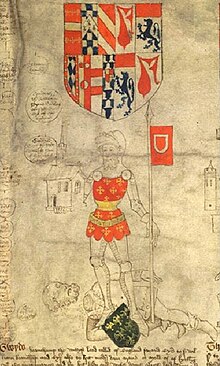Piers Gaveston | |
|---|---|
| Earl of Cornwall | |
 15th-century representation of Gaveston lying dead at the feet of Guy de Beauchamp | |
| Born | c. 1284 |
| Died | 19 June 1312 (aged 27–28) Blacklow Hill near Warwick, Warwickshire, Kingdom of England |
| Buried | Kings Langley, Hertfordshire 51°42′56″N 0°27′25″W / 51.71559°N 0.45692°W |
| Spouse(s) | Margaret de Clare |
| Issue |
|
| Father | Arnaud de Gabaston |
| Mother | Claramonde de Marsan |
Piers Gaveston, 1st Earl of Cornwall (c. 1284 – 19 June 1312) was an English nobleman of Gascon origin, and the favourite of Edward II of England.
At a young age, Gaveston made a good impression on King Edward I, who assigned him to the household of the King's son, Edward of Caernarfon. The prince's partiality for Gaveston was so extravagant that Edward I sent Gaveston into exile, but he was recalled a few months later, after the King's death led to the prince's accession as Edward II. Edward bestowed the Earldom of Cornwall on Gaveston, and arranged for him to marry Edward's niece Margaret de Clare, sister of the powerful Earl of Gloucester.
Gaveston's exclusive access to the King provoked several members of the nobility, and in 1308, the King again decided to send him into exile. During this absence, he served as the King's Lord Lieutenant of Ireland. Edward managed to negotiate a deal with the opposition, however, and Gaveston returned the next year. Upon his return his behaviour became even more offensive, and, by the Ordinances of 1311, it was decided that Gaveston should be exiled for a third time, to suffer outlawry if he returned. He did however return in late 1311 and, in 1312, he was hunted down and executed by a group of magnates led by Thomas, 2nd Earl of Lancaster, and Guy de Beauchamp, 10th Earl of Warwick.
It was alleged by medieval chroniclers (as discussed below under "Questions of sexuality") that Edward II and Piers Gaveston were lovers, a rumour that was reinforced by later portrayals in fiction, such as Christopher Marlowe's late 16th-century play, Edward II. This assertion has received the support of some modern historians, while others have questioned it. According to Pierre Chaplais, the relationship between the two was that of an adoptive brotherhood, and Gaveston served as an unofficial deputy for a reluctant king. Other historians, like J.S. Hamilton, have pointed out that concern over the two men's sexuality was not the crux of the nobility's grievances, which rather centred on Gaveston's exclusive access to royal patronage.